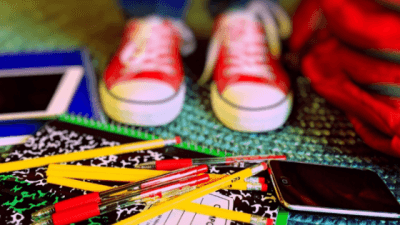Back to school is always the best time to get organized, but how can we make that last throughout the school year? Check out these tips and ideas!
Data Collection
I have personally tried several data collection methods, and I struggled in the past to find one that worked for me consistently, which lead to a mess of unorganized data by the end of the school year. In the past few years, I have found a system that works for me. I make a folder for each student I work with. Inside of that folder is their class schedule, any activities we are working on or are planning to work on, and a student data sheet. My data sheets include the service minutes, the student’s eligibility, the case manager, the grade and/or teacher, and the annual review date. Then I list all of the speech and language goals and leave spaces for therapy dates and notes. This way, I can look in one place for any info I may need quickly, and I can see the IEP goals as I’m doing therapy. Keeping up with this throughout the year is a breeze. When a student’s annual review comes up, I simply edit my word document and print new data sheets (download a copy of my blank data sheet). This may seem like too much to some people, and that’s okay. I think the bottom line is to find one method that works for you and to stick with it throughout the year. Check out https://blog.slpnow.com/student-data/ for a roundup of data collection methods.
Meetings
To stay organized about meetings, I use a planner (Google Calendar is also good), but I also make a spreadsheet in the fall that helps keep me on track throughout the year. On my spreadsheet, I list the annual review date and the 3-year re-eval date for each student on my caseload. I sort it by date so I can be on top of what meetings are coming up. Sometimes teachers will forget to tell me that a meeting is scheduled, so the spreadsheet comes in handy! This year, instead of just putting the meeting dates in my planner, I am also putting IEP due dates in my planner (typically 2 weeks prior to the meeting) so that I can make sure I have my information entered in plenty of time. So far, so good.
Therapy Materials
Being primarily a high school SLP, I don’t have tons of toys and materials. Most of what I have is a collection of Teachers Pay Teachers or self-created materials. I like to store anything I create or download electronically first and foremost. That way, I can always print it if I lose the hard copy. I have a folder on my desktop called “therapy materials” which is further broken down by theme (fall activities, Valentine’s Day, etc.) as well as targeted skills (vocabulary, listening comprehension, articulation, etc.). When I print materials that can be used several times, I like to laminate them and store them in file folders. I have seen SLPs who use clear ziplock baggies in bins (check out https://thespeechroomnews.com/2012/11/storage-organization.html) to store these types of activities, which I LOVE but don’t have space for. I organize my physical file folders similarly to the way I do on my computer, by theme and skill. Additionally, I keep my “go-to” materials out and ready to grab when I need them. The biggest advice I can give to keep materials organized is to have a home for everything. Put the materials you use away at the end of the day, or at least on Friday. This will help eliminate clutter and ensure that you can always find what you’re looking for.
I wish you the best of luck with staying organized and having a fun and successful school year!
Author: Susan Wesolek, M.S., CCC-SLP

